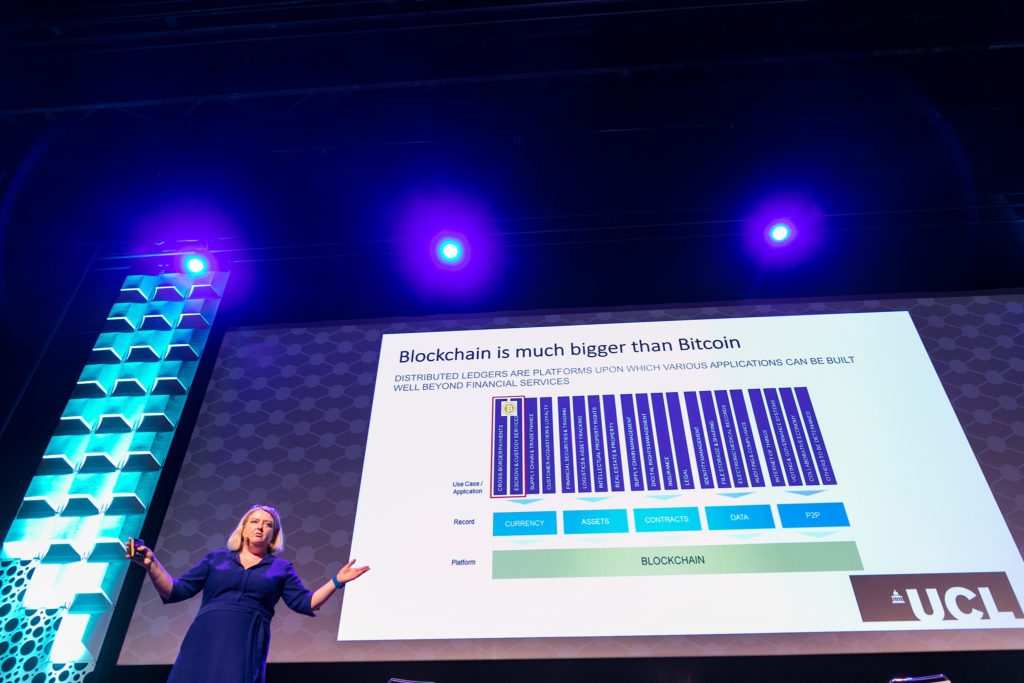
Blockchain is bigger than Bitcoin: Interview with Dr Catherine Mulligan, CTO Datanet
During The Linux Foundation’s recent Open Networking Summit Europe 2018, I had the opportunity to speak with Dr. Catherine Mulligan, CTO, DataNet and Visiting Research Fellow at Imperial College Centre for Cryptocurrency Research and Engineering, a Senior Research Associate at UCL in Blockchain and a Fellow and Expert Member of the World Economic Forum’s Blockchain Council.
Being a novice in all things Cryptocurrency and Blockchain I felt somewhat at a disadvantage about my knowledge of these areas. However, when I attended Catherine’s keynote presentation and had the chance to speak with her afterwards I started to get a better overview. Here are some of my main insights and takeaways.
Understanding the origins of bitcoin and blockchain: back to the future.
To learn about the origins of bitcoin, cryptocurrencies and blockchain I found it useful to read Satoshi Nakamoto’s original paper: Bitcoin: A Peer-to-Peer Electronic Cash System published in 2008.
Catherine Mulligan filled me in a little bit more:
“Satoshi Nakamoto was an anonymous person or a group of people that have chosen to remain anonymous. They came up with the idea of a digital currency that finally solved the ‘double spend’ problem.”
The ‘double spend’ problem occurred when:
– Person A electronically gave €5.00 to Person B
– Person B could copy and paste it and then electronically give the exact same amount to Person C, thus creating the problem of ‘double spend’.
Satoshi Nakamoto’s solution to this problem created two things:
1. Cryptocurrencies
2. Blockchain
What are you most interested in?
“Blockchain is what I’m most interested in today. You can’t have a cryptocurrency without some form of blockchain. You can definitely have a blockchain without cryptocurrency elements to it.
I’m particularly interested in something that would be classified as enterprise level blockchains. These generally don’t have currency elements associated with them. What they do is to take and leverage the idea of blockchain that:
- creates irrefutable transnational records between parties and allows a group of untrusting parties to create consensus that a transaction has occurred.
- allows for the creation of decentralized applications. Often referred to as smart contracts.
- gives us a historical transaction record.”
Catherine believes:
“Blockchain represents a fundamental transformation for the manner in which we, and our customers, will do business.”
Bitcoin and cryptocurrencies are just two examples of what can be built on blockchain.
Other areas and industries where it can be used that go beyond financial services are:
- supply chain
- digital rights management
- insurance
- digital assets
- financial securities
- real estate and property
- legal
- medical health records
- identity management
Blockchain in Shipping
During the ONS Summit, Ignacio Verona Rios, Red Hat EMEA, Senior Solution Architect at Telco Technology Office, Madrid presented an example of how blockchain is being used in the shipping industry. This blockchain-enabled solution known as TradeLens is the result of a collaboration agreement between IBM and Maersk.
However, when digging a little deeper I found that there are mixed reactions about the value of using this platform which are being voiced by various members of the shipping industry. Questions are being raised as to whether other alternative methods could be explored and used.
How could blockchain benefit Industry 4.0 and the software supply chain?
“I think what’s extremely important for Industry 4.0 from a supply chain perspective is actually this idea of the software supply chain.”
Catherine asked these important questions:
“Looking at the open source community today, how do we track, trace and verify all the pieces of code that go into an actual open source piece of software?
How do we guarantee that someone hasn’t snuck some malware, or something into it?
It’s been packaged up, so you can actually see some ways that blockchain could help with the data integrity.”
Another example:
“Your mobile phone device has a lot of software on it. It has many different components that have been patched and put together, so just even for the manufacturer who could understand where all of the software has come from. It also provides a lot of information for them in their supply chain analysis and assessment.”
What impact will blockchain have on the end user, e.g. the ordinary person on the street?
“I have two answers to that:
- You shouldn’t as an end user understand that blockchain is being used. The blockchain or a distributed ledger really are just new ways to manage data in a different way.
- It will affect your life quite a bit. In the research project DataNet* that I spoke about, it would put you in control of your data. It would give you a way to interact with government and industry that completely redefines you as a consumer to be in charge of your data.”
Following Dr. Catherine Mulligan’s keynote presentation at ONS Europe and my interview with her I now have a better understanding about blockchain. It has the ability to transform how business is done in the future, reduce complexity, provide cost savings and increase revenue in the long-term. However, it would be wise for businesses and industries to consider the benefits that blockchain has to offer, and to compare them against other alternative methods before making a final decision to use this platform.
*(Dr. Catherine Mulligan’s DataNet partners are: Dr. Zeynep Engin, Founder/CEO Gov Tech Lab and Professor Philip Treleaven, Chair of Advisory Board GovTech Lab)
-
Original article written by Catherine Duggan and published in Irish Tech News:
INTERVIEW WITH DR. CATHERINE MULLIGAN, CTO, DATANET AT ONS EUROPE: BLOCKCHAIN IS BIGGER THAN BITCOIN
